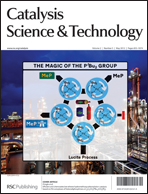The synthesis and properties of a series of unsymmetrical diphosphines o-C6H4(CH2PtBu2)(CH2PR2) are reported where R = C6H5 (La); p-CH3C6H4 (Lb); o-CH3C6H4 (Lc); o-CH3CH2C6H4 (Ld); o-CH3OC6H4 (Le); 2,4,6-(CH3)3C6H4 (Lf); CH(CH3)2 (Lg); or PR2 = PCg (Lh) where PCg is 6-phospha-2,4,8-trioxa-1,3,5,7-tetramethyladamant-6-yl. Hydromethoxycarbonylation of ethene under commercially relevant conditions is catalysed by the Pd complexes of each of the ligands La–ha–h to give methyl propanoate in >99% selectivity with catalytic activities comparable to those obtained with o-C6H4(CH2PtBu2)2 (L1) or o-C6H4(CH2PCg)2 (L55). The catalysts derived from Lc, Ld and Lh are more active than the catalyst derived from La or L1; these ligands have in common, a PR2 donor that is more bulky than the PPh2 present in La. Treatment of [PtCl(CH3)(cod)] with La–ha–h gave [PtCl(CH3)(L)] as mixtures of 2 isomers 1a–h and 2a–h. The major isomer in each case was 1a–h with the CH3 ligand trans to the PtBu2 group; the diastereoselectivity of this reaction for products 1a–h ranges from 88% to over 99%. The crystal structures of 1b, 1c and 1e have been determined. Fluxionality associated with chelate ring inversion has been detected for 1c by variable temperature 31P NMR spectroscopy. The 31P NMR data are compared for the complexes [PtCl(CH3)(L)], [Pt(CH3)2(L)] and [PtCl2(L)] where L = Lh, L1 or L55. The crystal structure of [Pt(CH3)2(Lh)] (4h) has been determined and shows that PCg is sterically less demanding than PtBu2 in this complex. Treatment of 4h with HCl gave a 1 : 1 mixture of 1h and 2h that equilibrated over 5 h to a 70 : 1 mixture. Treatment of an equilibrium mixture of 1h and 2h with isotopically labelled 13CO gas gave a single acyl complex [PtCl(13COCH3)(Lh)] (5h) with retention of configuration at Pt, i.e. the 13COCH3 is trans to the PtBu2 group. Mechanisms for the CO insertion are discussed which are consistent with the observed stereochemistry. The palladium complexes [PdCl(CH3)(Lh)] (7/8) also reacted with labelled 13CO to give a single acyl species [PdCl(13COCH3)(Lh)]. Treatment of [PdCl(13COCH3)(Lh)] with MeOH rapidly gave CH313COOMe.

You have access to this article
 Please wait while we load your content...
Something went wrong. Try again?
Please wait while we load your content...
Something went wrong. Try again?


 Please wait while we load your content...
Please wait while we load your content...